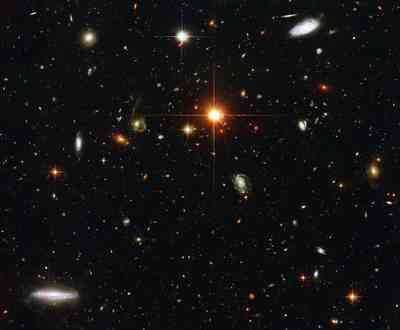Avi Blizovsky

Direct link to this page: https://www.hayadan.org.il/hubble140805.html
Looking deep into the depths of the universe, the Hubble Space Telescope was able to track Beaver galaxies. All of them are in a tiny observation area in space and have unique characteristics. Some of them are big, some are small, some are relatively close but most of them are very far. Hundreds of these pale galaxies were never seen until Oren was captured by Hubble.
This image represents a typical view of our view towards the deep universe. For the photo, Hubble looked down a long corridor of galaxies melting across billions of light years in space, and this also means looking back billions of years in time. The field visible in the image covers a relatively small area of the sky, a fraction of the surface of the full moon, but nevertheless full of a rich population of a variety of galaxy types.
Quite a few of these galaxies are full size galaxies and are scattered all over the image. These galaxies are easy to spot because they are relatively close to us. Some of these galaxies are flat-disk spirals that appear face-on or side-on, and in many intermediate positions as well. Elliptical galaxies and more exotic galaxies such as those that have a bar or tidal waves have also been observed.
Many galaxies look small in the picture and that is simply because they are further away, some billions of light years away. Thus we see these galaxies as they were when the universe was young than at the time when we see the nearest large galaxies. One red galaxy toward the lower left versus the bright star in the center acts as a magnifying lens for a large galaxy behind it. The light from the distant galaxy bends near the center of the galaxy and forms a broken arc.
Scattered among the thousands of galaxies in the image are at least a dozen background stars that reside in our Milky Way. The brightest among them is the red object in the center of the image. It is easy to distinguish between these stars and the galaxies due to the characteristics of light propagation. These refractions that look like hairs coming out of the star are caused by the passage of light through the optical systems of the telescope.
The image is composed of multiple exposures of a single field taken with the advanced survey camera. The image taken in September 2003 was a bonus image since other instruments of the spacecraft needed a 40-hour orientation towards a single point. It was one of the longest exposures ever made by Hubble.
For the announcement of the Space Telescope Science Center on the Universe Today website
The Sage of the Galaxies
https://www.hayadan.org.il/BuildaGate4/general2/data_card.php?Cat=~~~233104095~~~181&SiteName=hayadan
